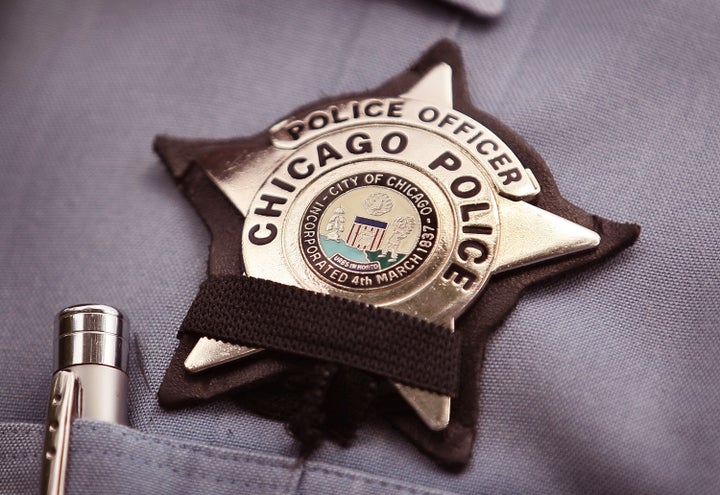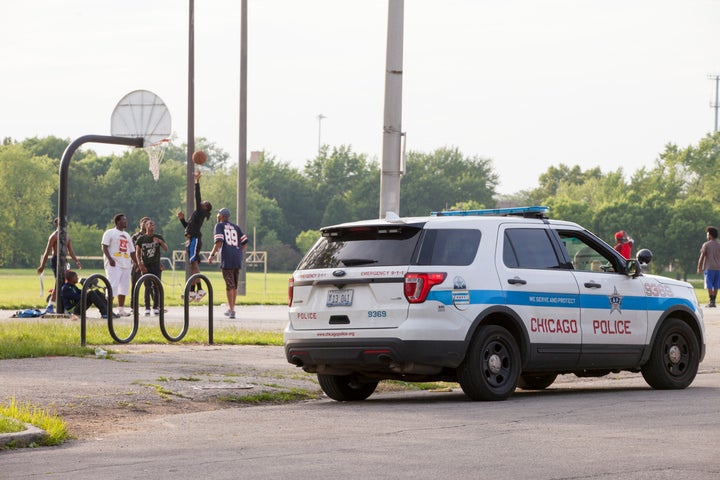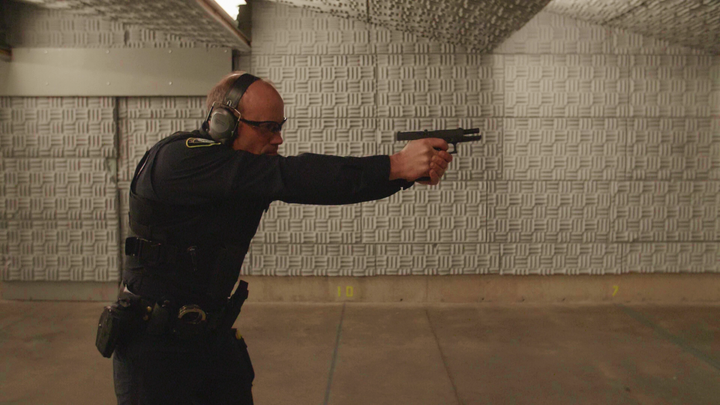As an officer for the Chicago Police Department, Carrie Steiner grew numb to trauma.
One day in 2001, while waiting for her partner during roll call, she was struck with the news of his death. He had struggled with alcoholism and died of positional asphyxia in his car after drinking the night before.
“I had to suck it up so no one would see me cry,” Steiner told HuffPost.
She excused herself to the bathroom and wept. When she finally composed herself, she was sent out on patrol, alone and without her partner.
“You just don’t want to feel those feelings, so you try to push them away. You have a job to do,” said Steiner, who held her position for 13 years. “You get more cynical. You get more hypervigilant and untrusting — you start to feel that more people are doing bad things to each other than good things to each other.”
Death became a common occurrence for the department. Today, the CPD has one of the highest rates of police officer suicide in the country, said Anthony Guglielmi, the department’s chief communications officer.
More recently, within an eight-month period between summer 2018 and March of this year, six officers died by suicide in Chicago. But the problem is a national one: Over the past three years, more cops have died by suicide than in the line of duty. And so far in 2019, 159 officers have already died by suicide nationwide, according to Blue H.E.L.P., a national organization dedicated to eliminating mental health stigma among police.
Steiner said she doesn’t find these statistics shocking because she and her colleagues have experienced firsthand the traumatic and horrifying incidents that first responders face daily. They’ve seen families and children die. They’ve seen people burn alive. They’ve seen open wounds of all shapes and sizes. They have faced death themselves.
Nationwide, few mental health resources are provided at work for law enforcement officers. Post-traumatic stress disorder, depression and insomnia are among the lasting consequences of a career in law enforcement, for police and corrections officers alike. In fact, law enforcement workers report experiencing anxiety-related mental health conditions at higher rates than the general population, according to the National Alliance of Mental Illness. Their work makes them more vulnerable and can often lead to destructive habits, such as alcoholism and drug abuse.
After seeing many of her colleagues in pain — and bearing the burden of trauma without the department’s support — Steiner decided to take matters into her own hands. She got her license to practice psychology and created the First Responders Wellness Center, a place where officers dealing with trauma can talk openly without judgment or fear of retribution.
At the center, she teaches officers adaptable coping techniques they can use on the job, and she allows her clients to carry their guns around — which is often prohibited at other therapy and wellness centers.

To combat the growing number of reported suicides, Steiner and organizations like Blue H.E.L.P. are trying to create spaces where law enforcement workers can heal and talk about difficulties on the job. In many areas, including Chicago, these spaces can be hard to come by.
Chicago is a community at odds with its police force, making tensions even higher for both officers and citizens. Chicago Police Department has been put under a microscope since reports found that local law enforcement was prone to “implicit” racial bias in its communities of color.
In 2017, the U.S. Department of Justice ordered the CPD to change its ways through a consent decree, which forced the city to reform its police training, policies and practices.
“CPD has a history of serious problems endangering the lives of both residents and police officers,” the consent decree website reads. “That history has had terrible consequences for both police and residents. African American and Latino communities, in particular, have felt targeted by racially discriminatory policing, and city taxpayers have paid more than $930 million in settlements for improper police conduct.”
The Chicago Police Department is 14 times more likely to use force against Black men than against white men, according to a report by The Invisible Institute and The Intercept.
On top of the tense relationship between the department and the people they serve, the city has been plagued with a higher crime rate than the national average and with some of the highest homicide rates in the country.
In 2016, Chicago accounted for more than 20% of the national murder rate increase even though the city accounts for less than 1% of the U.S. population. Nationwide, there were 5.3 murders for every 100,000 people that year. In contrast, Chicago has a 27.9 homicides per 100,000 people — though cities like St. Louis and Detroit had higher rates that year as well.

Despite the consistent on-the-job trauma, law enforcement jurisdictions aren’t required to have resources to help officers cope — and if officers do seek help, Steiner and other advocates said it’s often discouraged and seen as a sign of weakness to talk to professionals. Mental illness is looked down upon in law enforcement agencies. The macho culture stigmatizes emotional trauma as a sign of weakness, forcing officers into silence.
“You don’t know what a person is going through unless you talk to them, you know, some people won’t speak on it,” Karla Parris, a former correction officer who worked for the New York Department of Corrections for 21 years, told HuffPost. “That’s hard to see your fellow officers going through depression. You come in with somebody, you see them sick, and then next thing you know, they’re gone.”
Some police officers fear they’ll lose their job, potential promotions or respect for admitting they need or are seeking mental health care.
“The culture contributes to officers not getting help,” Karen Solomon, president and co-founder of Blue H.E.L.P, told HuffPost. “Officers have been let go because of the stigma and have their gun taken away.”
The CPD provides its employees with access to counselors via its Employee Assistance Program and an internal campaign called “You Are Not Alone CPD.” Guglielmi, the department’s communications officer, said it’s offering many new services in order to help its officers.
“In addition to doubling the number of counselors we have (5 to 11), we … put up various posters and print materials throughout districts and headquarters,” Guglielmi said in a statement to HuffPost. “We have a peer support network that is made up of police officers who have gone through similar struggles with depression or challenges with the job. This is a peer-to-peer program that officers can call confidentially to talk to one of your colleagues that may have been through the same struggle.”
However, Steiner said she felt the program didn’t always provide a safe space to address the pain and trauma of work, so she decided to take matters into her own hands.

Steiner’s wellness center works with paramedics, law enforcement officers and veterans, and it specializes in crisis management, intervention and therapy. Law enforcement officers from across the country come to her office seeking help. Since there are so few resources, they’re willing to make the trip to Illinois in order to find a therapist that understands their needs.
Similarly, Solomon launched Blue H.E.L.P. to increase awareness of law enforcement suicide and offer resources to families who are dealing with loss. The organization keeps track of the number of officers who die each year, including police suicides, and has a database filled with personal stories.
Although it’s unclear whether the higher rates of suicide are due to an increase in suicides or more accurate reporting, Solomon said the growth in the numbers signals a need for more resources and training to make both employers and employees aware of their ability to seek and provide help.
“The people at the top need to start sharing their trauma,” she said.
Parris recalled what it was like working in Manhattan prisons and the heaviness she felt coming home from work some days. She worked long hours and often felt pressure from higher-ups. She didn’t get to see her family much and could envision horrific scenes from work when she left the walls of the prison.
“If you knew an inmate and you spoke to them all the time and you never expected them to do something like that and you come in the next day and you hear that they killed themselves,” Parris said. “Yeah, he’s an inmate, but he’s still a person. It puts you on edge, because now you’re making tours [around the facility] and the last thing you want to see is somebody hanging.”
Parris said she witnessed the toll that the job took on her counterparts — how it slowly affected their health, their mentality and their relationships.
To change the way law enforcement copes with their trauma, officers should be given readily available resources to deal with these kinds of experiences, Steiner and Parris said.
Coping with trauma starts with recognizing the signs — the fatigue, the numbness, the loss of appetite, insomnia, according to Steiner, Parris and Solomon. Getting help is possible, Steiner said, and suggested looking to one’s peers for comfort. Ultimately, the system of stigma can help save lives.
“There are a lot of success stories,” Steiner said. “It’s not the end.”
Lena Jackson contributed reporting.
If you or someone you know needs help, call 1-800-273-8255 for the National Suicide Prevention Lifeline. You can also text HOME to 741-741 for free, 24-hour support from the Crisis Text Line. Outside of the U.S., please visit the International Association for Suicide Prevention for a database of resources.
REAL LIFE. REAL NEWS. REAL VOICES.
Help us tell more of the stories that matter from voices that too often remain unheard.
Credit: Source link